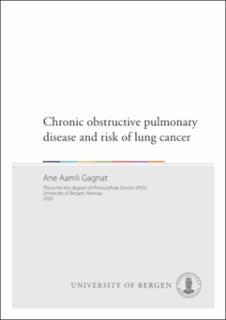| dc.contributor.author | Gagnat, Ane Aamli | |
| dc.date.accessioned | 2020-12-04T08:49:38Z | |
| dc.date.available | 2020-12-04T08:49:38Z | |
| dc.date.issued | 2020-12-08 | |
| dc.date.submitted | 2020-11-16T21:22:06.923Z | |
| dc.identifier | container/33/f6/9c/5e/33f69c5e-2dba-47fc-a1ab-59f55c9e700a | |
| dc.identifier.isbn | 9788230858035 | |
| dc.identifier.isbn | 9788230852842 | |
| dc.identifier.uri | https://hdl.handle.net/11250/2711845 | |
| dc.description.abstract | Abstract
Background: Lung cancer is a main cause of death in patients suffering from COPD and smokers with COPD have an increased risk of lung cancer compared to healthy smokers. COPD comprises a broad range of features, including emphysema, chronic bronchitis, asthmatic features, and acute exacerbations in COPD (AECOPD). We hypothesized that some of these features of COPD represent a higher risk of lung cancer and non-pulmonary cancer.
Aims:
1. To explore if emphysema and airway wall thickness assessed quantitatively on CT increase the risk of lung cancer and non-pulmonary cancer.
2. To investigate if acute exacerbations in COPD are associated with the risk of lung cancer, and to see whether this association differs based on coexisting asthma.
3. To examine and compare two lung cancer screening scores in our population of patients with COPD.
Materials and Methods: Participants included in the analyses of all three papers were from the GenKOLS study in Bergen, Norway, conducted between January 2003 and January 2005. Participants were 40-85 years of age and had a smoking history of at least 2.5 pack-years at baseline. GenKOLS was conducted as a case-control study. COPD was diagnosed when post-bronchodilator FEV1/FVC was <0.70 and FEV1<80% predicted. Baseline examinations included a detailed questionnaire on smoking habits, respiratory symptoms, and disease history, as well as pulmonary function tests. Approximately half of all the participants had a chest CT scan. Baseline data were linked to incident cancer data from the Cancer Registry of Norway throughout the year 2013. All subjects with a cancer diagnosis before inclusion were excluded from the analyses. In Paper III, the subjects were divided into high and low risk according to the National Lung Cancer Screening Trial (NLST) inclusion criteria, and the COPD-Lung Cancer Screening Score (COPD-LUCSS). Cox proportional hazards regression were used to examine the hazard ratios (HR) for the effect of the predictor variables on the risk of cancer.
Results:
1. After adjustment for age, sex, pack-years, age of onset of smoking, smoking status at baseline, and FEV1, the baseline amount of emphysema remained a significant predictor of the incidence of non-pulmonary cancer and lung cancer. Airway wall thickness did not predict cancer independently.
2. AECOPD was significantly associated with lung cancer during ten years of follow-up only in COPD patients without asthma. The analysis was adjusted for sex, age, smoking variables, FEV1, and BMI.
3. The NLST selection criteria, and the COPD-LUCSS were both significantly associated with the risk of lung cancer. The area under the curve values showed that both models have poor discriminatory abilities in our cohort. There was no significant difference in the discriminatory ability between the scores.
Conclusions: Some features of COPD were significantly associated with the risk of lung cancer, and even non-pulmonary cancer. Emphysema was significantly associated with lung cancer risk and risk of non-pulmonary cancer, whereas airway wall thickness was not. AECOPD was associated with an increased risk of lung cancer only in COPD patients without asthma. Some of these features of COPD might be of use in evaluating those who could benefit from lung cancer screening.
Although both the NLST selection criteria and the COPD-LUCSS, were associated with an increased risk of lung cancer, both scores had poor discriminatory abilities in our cohort of COPD patients. More studies are needed to find better models to target those at higher risk of lung cancer. | en_US |
| dc.language.iso | eng | en_US |
| dc.publisher | The University of Bergen | en_US |
| dc.relation.haspart | Paper I: Gagnat AA, Gjerdevik M, Gallefoss F, Coxson HO, Gulsvik A, Bakke P. Incidence of non-pulmonary cancer and lung cancer by amount of emphysema and airway wall thickness: a community-based cohort. Eur Respir J. 2017;49(5):1601162. Full text not available in BORA due to publisher restrictions. The article is available at: <a href="https://doi.org/10.1183/13993003.01162-2016" target="blank">https://doi.org/10.1183/13993003.01162-2016</a> | en_US |
| dc.relation.haspart | Paper II: Gagnat AA, Gjerdevik M, Lie SA, Gulsvik A, Bakke P, Nielsen R. Acute exacerbations of COPD and risk of lung cancer in COPD patients with and without coexisting asthma. European Clinical Respiratory Journal. 2020;7(1):179954. The article is available in the main thesis. The article is also available at: <a href="https://doi.org/10.1080/20018525.2020.1799540" target="blank">https://doi.org/10.1080/20018525.2020.1799540</a> | en_US |
| dc.relation.haspart | Paper III: Gagnat AA, Gulsvik A, Bakke P, Gjerdevik M. Comparison of two lung cancer screening scores among patients with chronic obstructive pulmonary disease: A community study. Clin Respir J. 2019;13(2):114-9. The article is available in the main thesis. The article is also available at: <a href="https://doi.org/10.1111/crj.12988" target="blank">https://doi.org/10.1111/crj.12988</a> | en_US |
| dc.rights | In copyright | |
| dc.rights.uri | http://rightsstatements.org/page/InC/1.0/ | |
| dc.title | Chronic obstructive pulmonary disease and risk of lung cancer | en_US |
| dc.type | Doctoral thesis | en_US |
| dc.date.updated | 2020-11-16T21:22:06.923Z | |
| dc.rights.holder | Copyright the Author. All rights reserved | en_US |
| dc.description.degree | Doktorgradsavhandling | |
| fs.unitcode | 13-25-0 | |
